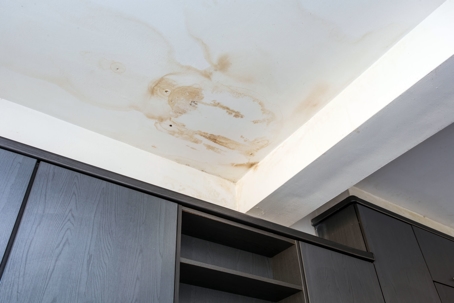One of the last problems any homeowner wants to deal with is water leaking or flooding into their home from their HVAC system. Unfortunately, this issue is a lot more common than you might think, especially in high-efficiency systems that are not routinely maintained.
Below, we’ll explain what causes HVAC systems to leak or flood water and how you can prevent this problem to avoid water damage.
Where Is All That Water Coming From?
Air conditioners (and high-efficiency furnaces) act like dehumidifiers. They pull moisture out of the air, which results in condensation. That water (condensate) drips down the indoor coil into a drain pan. From there, the water leaves your home through a drain line, typically made of a PVC pipe.
An air conditioner can produce anywhere from 20 to 50 gallons of water through condensation per day! It’s important to note that the more efficient your AC is, the more condensation it will produce. This is because new, high-efficiency air conditioners have bigger coils and move air more slowly over the coils. The larger surface area and slower movement allow more moisture to be removed as the air passes.
Why Do HVAC Systems Flood or Leak?
Now that we know where the water comes from, we’ll look at why it floods. Typically, when we get a call about water leaking through someone’s ceiling, it’s because the water in their AC’s drain pan has overflowed. The most common reason this happens is because dirt, dust, or debris is clogging the drain line. As a result, water can’t leave the home fast enough and ends up flooding the drain pan.
Air conditioners can also leak water if there’s a hole or crack in the drain pan. These pans are made of metal, which means that they can corrode over time and become brittle. If enough rust forms, parts of the pan can break or flake off and make a gap through which water can leak.
How Can I Avoid Water Damage from My HVAC Equipment?
If you see water leaking through your ceiling, or if you notice water dripping out of your roof’s soffit or over a window, there’s a good chance your drain line is already clogged. The best way to avoid this issue is to get your HVAC equipment maintained twice a year: once in the spring and once in the fall. At Rescue Air and Plumbing, our technicians will flush out your drain line to get rid of any buildup that might prevent water from draining.
We also recommend installing a float switch. It sits in your drain pan, and when the water rises to a certain level, the device will turn your unit off to keep it from making more condensation and causing a flood. This is a smart safety net to have in place particularly if you’re upgrading to a high-efficiency system, and you’re not sure if your current drain is up to the task of handling up to 50 gallons of condensation per day.
From routine maintenance to emergency service, our HVAC pros as Rescue Air and Plumbing are ready to help! Call us at (972) 201-3253 for 24-hour service, or contact us online.

